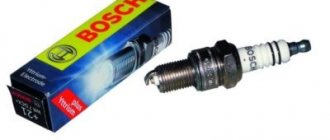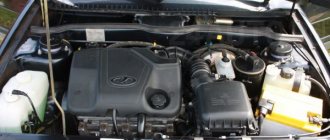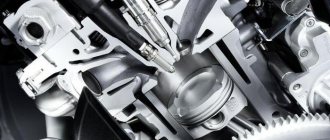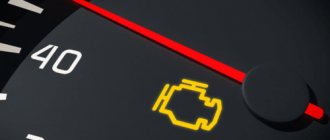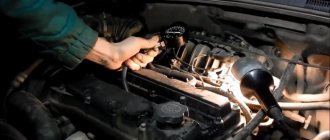If the VAZ 2110 8-valve engine, the 8-valve injector begins to show signs of instability in operation, this means that 1 of the cylinders has stopped performing its functions. Such a breakdown should be repaired immediately, because unburned fuel mixture enters the crankcase and changes the viscosity of the oil. As a result, the contacting surfaces of the unit parts are not covered with an oil film of sufficient consistency. There is increased wear of elements.
Causes of unstable engine operation
Content
When a VAZ 2110 engine with an 8-valve injector malfunctions, the reasons are sought in a certain sequence.
Systems and individual components are checked:
- electrician;
- cylinder operation;
- ignition;
- degree of depressurization;
- air supply;
- fuel injectors;
- pistons and rings;
- sensors
Electrics
When the engine of a VAZ 2110 8-valve injector malfunctions, the reasons, first of all, should be sought in the electrics.
Only after this is it possible to establish unstable operation of the cylinder. First, the candles are inspected:
- Using a special key, they are unscrewed sequentially.
- A superficial inspection of the insulator is being carried out.
- Often the cause of a weak spark or its complete absence is surface deposits, which are eliminated.
- Check that the spark plug gap is set correctly.
- The cap is inspected for wear.
When the VAZ 2110 engine has trouble with the 8-valve injector, the reasons may lie in the high-voltage wires. To do this, a tester is used that checks them for resistance, the optimal value of which is 5 ohms. If the wires do not meet this specification, they need to be replaced.
There is also a lack of spark due to the following reasons:
- ignition coil malfunction;
- broken wires.
The spark plug operation is checked in the following sequence:
- The spark plug tip is inserted into the wire.
- Its opposite end is applied in mass.
- The starter turns on.
- If a spark jumps, it means the element is working.
- If it is missing, the spark plug requires cleaning or replacement.
Cylinder operation
If the VAZ 21108 engine has 8 valve injector valves, then a possible cause may be poor cylinder performance.
When it is determined that everything is in order with the electrical part, the following actions are carried out:
- The hood lid is installed in the open position and the VAZ car starts.
- To determine the tripping of one of the cylinders, 1 wire is removed one at a time.
- Each time you should listen to the tone of the machine's noise. Her work must become unsustainable.
- If the next time you remove the wire, the sound does not change, it means that this cylinder has a malfunction.
Knowing that the voltage is coming through the wire, a search is being carried out for another reason why the VAZ 2110 engine is having problems with the 8-valve injector.
Ignition
VAZ 2110 engine 8 valves, the injector may trip if the coil is faulty.
To check, the following steps are carried out:
- The terminal is disconnected from the coil.
- It has 4 connectors: power, ground and 2 control lines.
- A multimeter is connected in series to each connector.
- The voltage at 1 connector must correspond to 12 V.
- At ground the resistance should be around 1 Ohm.
- By connecting the device to the control lines, the starter turns the crankshaft. The device should show at least 0.3 V.
If 1 of these indicators is not met, this will be the reason why the VAZ 2110 8-valve engine has an injector problem.
Depressurization of the system and air leaks
If the VAZ 2110 engine has trouble, the cause of the malfunction may lie in excess air supply.
As a result of depressurization, uncontrolled suction occurs, which leads to disruption of the functioning of the system. To check for a leak, carry out the following steps:
- There is a valve next to the air filter that closes.
- This leads to an artificial increase in pressure.
- It immediately becomes clear where the air leak is coming from.
Insufficient amount of air in the combustible mixture
If there is a lack of air in the combustible mixture, the VAZ 2110 8-valve engine and 8-valve injector may also begin to stall.
The following problems exist:
- The capacity of the air filter has deteriorated. This happens due to its contamination. To check the unit, dismantle it and start the car. If no changes are observed, then this unit requires replacement.
- Another reason why the VAZ 2110 8 valve injector troits is the throttle. This element needs constant monitoring. During maintenance, in parallel with changing the oil and all filters, this part must be cleaned. For this purpose, VD-40 is used, which removes dirt well from the surface.
Fuel injectors
VAZ 2110 engine 8 valves, the injector may triple due to a malfunction of the injectors, as well as the fuel rail.
To understand how faulty the injectors are, a stand is used that provides complete information about them. In some cases, they need cleaning, which is also carried out at the stand. The ramp is also subjected to external examination for cracks or dents.
Pistons and rings
A malfunction in the piston system often leads to the fact that the VAZ 2110 engine begins to misfire.
It depends on the mileage traveled by the car. Unstable operation occurs for the following reasons:
- There is wear on the rings and pistons. Not only is there an increased consumption of lubricant, but the operation of the unit also deviates from the norm. In this case, you should hurry up with a major overhaul.
- Piston burnout. This happens because the rings allow oil to pass through, which burns in the piston. This leads to their burning out.
- When the valves burn, the gap increases. As a result, exhaust gases begin to flow, and the car's performance deteriorates.
These reasons lead to a decrease in compression. It is checked by adding oil to the cylinder. If its performance has increased, then the piston group requires replacement.
Sensors
If sensors fail, this affects the unstable operation of the car. This is due to the fact that the nodes send a signal to the electronic unit. If it is absent, the receipt of commands to control the machine stops.
To identify a malfunction, each sensor is checked individually until the faulty element is found.
Ignition
Before checking the entire system, it is necessary to identify the inoperative cylinder. This is done as follows: the high-voltage wires are pulled off the spark plugs one by one.
At the same time, the working cylinders react to this action, the engine begins to wither. If the non-working cylinder is disconnected from the ignition, the engine will not react to this in any way. After determining the inoperative cylinder, unscrew the spark plug. Problems with it or with the ignition system are indicated by the presence of fuel residues on it, the spark plug is “wet”. You can try replacing the spark plug and installing another high voltage. You may find that when you start the engine, it runs fine. If this does not happen, you need to continue checking. The simplest solution is to replace your module with one that is known to work. If this is the problem, then the engine should start working correctly. Also possible. To do this, you need to measure the resistance at the terminals. This needs to be done in pairs. Combine cylinders 1 and 4, as well as cylinders 2 and 3. The resistance should be between 5.2 and 5.5 ohms. The ignition module cannot be repaired; if it malfunctions, it will have to be replaced.
Reasons for engine tripping 16 valve injector
If the VAZ 2110 engine has problems with the 16 valve injector, then the reasons have some features:
- High voltage coils. Their quantity is 4 pcs. They are located under the lid. It is removed during inspection. To establish the serviceability of each coil individually, the bolt located next to each element is unscrewed. Then the car starts and the terminal is removed. If the noise of the machine does not change, then the unit is faulty. Each coil is checked this way.
- Faulty sensors located on the crankshaft or camshaft lead to vehicle malfunction.
Crankshaft position sensor (CPS)
Often the engine stalls due to problems with the DPKV. To check, you will have to remove this sensor from the engine. Be sure to mark its position on the engine.
After removal, you need to measure the resistance of the sensor inductive coil. The multimeter should show a resistance between 550 and 750 ohms. Anything more or less indicates a sensor malfunction. It needs to be replaced. There are other testing methods, but they are “difficult to apply” in a regular garage.
Now a short video with another reason.
Causes of carburetor engine tripping
If the engine of a VAZ 2110 8-valve carburetor fails, then the reasons are as follows:
- Setting the quantity and quality of the mixture. The carburetor has mixture quantity and quality screws that need to be adjusted.
- If the engine of a VAZ 2110 fails, the reasons lie in clogged jets and idle channels.
- The gasket that allows air to pass through is broken. This makes the combustible mixture leaner.
- When the VAZ 2110 engine stalls, the cause may be a malfunction of the carburetor magnetic valve.
- The float system is not adjusted correctly. As a result, the fuel level decreases. This leads to the fact that the engine on the VAZ 2110 8 valves will operate unstably.
- The filters that allow gasoline to pass through are clogged.
- The ignition system distributor is malfunctioning.
If the engine in a VAZ fails, then you should start by checking the spark plugs. Most often the reason is their contamination. If this does not bring results, then you need to start looking for more serious reasons.
Why does the VAZ 2110 jerk when driving?
The phenomenon, which car enthusiasts call jerking, occurs due to a sudden change in the crankshaft speed when the gas pedal is in a stable pressed position.
If suddenly a VAZ 2110 jerks while driving, this causes anxiety and concern to the car owner. We need to do something urgently, but first we need to understand the reason. We will talk about some features of jerks and signals that help you understand why they occur.
During the start
Most often, when starting from a standstill, the highest stage of the jerk is observed - failure, that is, a very significant delay in the engine’s response to the pressed gas pedal. It happens that the engine stalls. It’s especially unpleasant when you’re standing, for example, in front of a traffic light, and someone behind you is already honking, and you’re frantically starting the car again.
A jerk when starting off occurs when the ECU (electronic control unit) gives a signal to start opening the throttle valve, that is, when transitioning from the XX mode to the driving mode.
Throttle position sensor
IN THIS WAY, THE QUANTITY OF FUEL SUPPLY THROUGH THE INJECTORS SHOULD INCREASE, WHICH DOES NOT OCCUR WHEN THE PRESSURE IS INSUFFICIENT IN THE FUEL LINE.
Potential culprits for the car moving jerkily when starting off:
- fuel pump , which is about to completely fail. This is evidenced by its peculiar periodic “howling” or an increase in its noise. The pump on an injection engine is listened to even before the engine itself is started - it is turned on initially from the battery, starting to pump fuel before turning on the starter. It is located inside the gas tank, so it becomes almost inaudible once the engine is running. In carburetor cars, the fuel pump is under the hood, you can hear it even when the engine is running;
- The fuel pump mesh is clogged with foreign particles that enter the gas tank along with low-quality gasoline at the gas station, or are formed in the tank itself due to condensation. This is why the gas tank should be flushed periodically;
- fuel filter , which is located under the hood. It also needs to be changed periodically;
- pressure regulator To replace it, you will need to remove and disassemble the fuel pump.
The first step is to check what pressure the fuel supply system produces. The check is carried out using a pressure gauge. It connects to a fitting located on the fuel rail (under the hood). We cannot give uniform readings, since it is different on different engines.
For some, a pressure below 325 kPa can be considered normal, while for others it is 400 kPa. That is, you need to look specifically at your instruction manual.
If the pressure gauge readings are too high, it means there is a malfunction in the fuel pressure regulator. If the readings are too low (less than 284 or 364 kPa, again, depending on the engine), replacing the fuel filter will help.
Problems with injection
Certain specific problems can cause tripping when the engine is running in a car:
- malfunction of the regulator responsible for idle speed;
- blockage in the injection nozzle;
- the fuel pump, air or fuel filter is clogged;
- the sensor responsible for the throttle position has failed;
- the ventilation system providing air to the engine crankcase is clogged;
- ECU is faulty.
Separately, it is necessary to note the problems of the “tens” with sensors. Although their cost is insignificant, problems with them arise quite often. They often require replacement. First of all, this applies to the sensor responsible for mass fuel consumption. The second most common problem is the sensor that is responsible for the throttle position. The risk zone is not complete without an idle air regulator. All these elements require constant monitoring of their condition.
The motor may not operate correctly if the firmware of the electronic control part is poor. This can happen if tuning is used unwisely. At high speeds the car operates normally, but at idle it starts to shake. Sometimes the ECU may have defects that cannot be corrected. In this case, the only way out of this situation is to completely replace the electronic unit.
It would be a good idea to check the exhaust manifold for leaks. It doesn’t hurt to inquire about the condition of the vacuum brake booster. If it malfunctions, the spark plugs may get wet, which will also cause the engine to start to “trouble.”
We can only hope that the article will help car owners in solving this problem.
Timing marks
If the camshafts are incorrectly aligned relative to the crankshaft
– the reason for the engine tripping. The opening and closing timing of the intake and exhaust valves will not coincide with the engine strokes.
For example, at TDC of the piston the valve may be closed, so a flash will occur not only in the cylinder, but in the intake or exhaust manifold, depending on which valve is not closed.
This may occur due to a stretched timing drive.
. As the chain or belt is used, it stretches. Therefore, the opening or closing angles may shift. This leads to engine tripping.
What to do
If you have checked everything: the spark plugs are in order, there is a spark everywhere, the quality of the mixture is at the right level, you need to check the timing marks. We look at the degree of belt tension. In the case of a chain, how “out” the tensioner is. If the marks are knocked down, then we set them as needed.
After troubleshooting, we fix the problem. If the motor stops running, the cause has been found and eliminated.
Solution methods
Now that the main causes have been identified, you can proceed directly to troubleshooting methods . Before we begin, it is worth noting that not all faults can be identified independently, much less eliminated. Let's look at what needs to be done to eliminate engine tripping.
Fuel rail and injectors
The most common cause of engine tripping is a malfunction of the injectors and fuel rail. To eliminate the cause, it is necessary to disassemble this element. The fuel rail is inspected for cracks and deformations. But with candles, not everything is as simple as it seems at first glance.
To determine the performance of the elements, they need to be run through a special stand, which will show whether the injector will work. If they become clogged, they must be cleaned at a nozzle cleaning stand, and if the element is completely faulty, then replace it with a new one.
Spark plugs and wires
Another reason why the power unit fails is the spark plugs and high-voltage wires. So, it is worth removing the elements from the engine and conducting diagnostics. Spark plugs, first of all, are inspected for integrity, and then checked on a special spark plug stand. If everything is in order with the spark plugs, then it is necessary to set the contact gap before installation.
High-voltage wires are checked with a conventional resistance tester. So, a good quality wire will have a resistance of 5 ohms. Deviation from this indicator is considered to indicate that the wires are not suitable for further use and must be replaced with new ones.
Sensors
Failure of several sensors can lead to the motor becoming unstable and tripping. This could be a failure of the TPS, IAC, camshaft sensor, or DMVR. When all these components fail, they signal the electronic engine control unit, which in turn outputs information to the driver. The malfunction can be eliminated by replacing the corresponding sensor.
There are two ways to determine the performance of the sensor - measuring each sensor one by one with a tester, or connecting to the on-board computer, where an error will pop up, decoding which you can determine the location of the problem.
Throttle valve
A faulty throttle valve can cause the engine to shake. To cure the malfunction, you need to dismantle the element and clean it. Today, there are a sufficient number of products on the auto chemical market that can be used to clean this unit.
But the most popular folk method remains carburetor cleaner, or VD-40. Both products clean out accumulated dirt and dust quite well.
Air filter
The air filter remains a known problem with engine tripping. Thus, untimely replacement of this element can lead to insufficient or incorrect formation of the air-fuel mixture. This is due to the fact that a dirty filter leads to poor air permeability and the engine simply begins to choke.
To eliminate the problem, it will be enough to replace the air filter element. Since the VAZ engine has simple design features, any motorist can cope with this task without much difficulty. So, to replace the air filter you need to get into the engine compartment. Then, unscrew the four bolts securing the air filter cover and change the filter element.
Why does a diesel engine stall when cold?
The problem when a diesel engine misfires when cold is no less familiar than its gasoline counterparts, but the range of searches for causes is somewhat narrower. In this case, engine tripping is often accompanied by bluish or white smoke from the exhaust.
- Firstly, it may be airing.
- Secondly, there may be a problem with the glow plugs.
- Thirdly, the cold injector jams.
Here are the three main and most common problems that can cause a situation where a diesel engine stalls when cold. However, valve clearances and incorrectly set timing marks and fuel injection pumps cannot be ruled out.
But still, before checking and changing everything, you should remember that modern engines do not tolerate “blind diagnostics”; there are too many similar symptoms for different faults.
